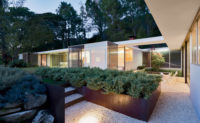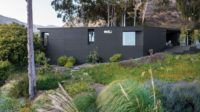Few municipal transit fleets have cruised through popular culture like the Big Blue Bus (BBB) of Santa Monica, California. “The blue bus is callin’ us. . . . ,” insisted Jim Morrison in the Doors song “The End.” A later model, starring in the 1994 movie Speed, careened through city streets, at risk of detonating a bomb if it slowed down.
Click on the slide show icon to see additional photos.
While the busses—colorful descendents of Santa Monica’s original blue livery jitney, from 1928—have been highly visible, the bus stops haven’t been so consistently easy to spot. But that will soon change, as the system’s 360 drop-off/pick-up points take on an identity as playful and Santa Monica-specific as the “Big Blue Bus” name (officially adopted in 1999).
In January, Lorcan O’Herlihy Architects (LOHA) won local City Council approval for “The Blue Spots,” a passenger-shelter prototype, flexible enough to meet diverse site constraints and rider volumes. LOHA is partnering with Bruce Mau Design in branding the shelters.
Like the beach umbrellas dotting Santa Monica’s shores, The Blue Spots will feature circular shading disks, supported on poles. This modular system of blue-painted steel “umbrellas,” designed to unify the current, ad hoc mix of stops, allows for clustered “parasols” at venues with high passenger volume, but as few as single ones at low-volume stops. With an average of 320 sunny days per year—but only four existing stops with shading devices—local riders have advocated for shade. Analyzing each stop’s unique orientation, LOHA positioned seating for maximum sun protection during peak ridership. In contrast to conventional shelters, few seats sit directly below the canopies (an enhanced sun-tempering feature, not ideal for the occasional windblown rain).
Recent city ordinances banning bus-shelter advertising allowed LOHA to dispense with standard walls. So, where conventionally boxy shelters would have blocked narrow sidewalks, the minimal poles fit, readily accommodating wheelchair access. A compact kiosk at each stop will include redesigned maps, timetables, and real-time bus arrival updates.
In the progressive spirit of BBB, longtime champion of mass transit with clean, renewable fuels, The Blue Spots will be sustainably fabricated and operated—with recycled and locally sourced materials, as well as solar panels, powering efficient LED downlights.
The budget is $6.9 million, with $3 million from the Federal Transit Administration and nearly $2.5 million from stimulus funds. The first, if not all 360 Blue Spots, should be up and running by the end of 2010.
So, just as “the blue bus is callin’ us,” even from heavy traffic, you may soon be spottin’ Big Blue Bus stops from way, way down the street.




Post a comment to this article
Report Abusive Comment